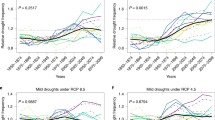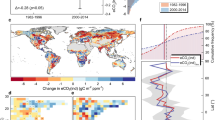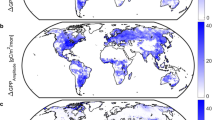Abstract
The atmospheric carbon dioxide (CO2) record displays a prominent seasonal cycle that arises mainly from changes in vegetation growth and the corresponding CO2 uptake during the boreal spring and summer growing seasons and CO2 release during the autumn and winter seasons1,2,3,4. The CO2 seasonal amplitude has increased over the past five decades, suggesting an increase in Northern Hemisphere biospheric activity2,5,6. It has been proposed that vegetation growth may have been stimulated by higher concentrations of CO2 as well as by warming in recent decades, but such mechanisms have been unable to explain the full range and magnitude of the observed increase in CO2 seasonal amplitude2,6,7,8,9,10,11,12,13. Here we suggest that the intensification of agriculture (the Green Revolution, in which much greater crop yield per unit area was achieved by hybridization, irrigation and fertilization) during the past five decades is a driver of changes in the seasonal characteristics of the global carbon cycle. Our analysis of CO2 data and atmospheric inversions shows a robust 15 per cent long-term increase in CO2 seasonal amplitude from 1961 to 2010, punctuated by large decadal and interannual variations. Using a terrestrial carbon cycle model that takes into account high-yield cultivars, fertilizer use and irrigation, we find that the long-term increase in CO2 seasonal amplitude arises from two major regions: the mid-latitude cropland between 25° N and 60° N and the high-latitude natural vegetation between 50° N and 70° N. The long-term trend of seasonal amplitude increase is 0.311 ± 0.027 per cent per year, of which sensitivity experiments attribute 45, 29 and 26 per cent to land-use change, climate variability and change, and increased productivity due to CO2 fertilization, respectively. Vegetation growth was earlier by one to two weeks, as measured by the mid-point of vegetation carbon uptake, and took up 0.5 petagrams more carbon in July, the height of the growing season, during 2001–2010 than in 1961–1970, suggesting that human land use and management contribute to seasonal changes in the CO2 exchange between the biosphere and the atmosphere.
This is a preview of subscription content, access via your institution
Access options
Subscribe to this journal
Receive 51 print issues and online access
$199.00 per year
only $3.90 per issue
Buy this article
- Purchase on Springer Link
- Instant access to full article PDF
Prices may be subject to local taxes which are calculated during checkout




Similar content being viewed by others
References
Bacastow, R. B., Keeling, C. D. & Whorf, T. P. Seasonal amplitude increase in atmospheric CO2 concentration at Mauna Loa, Hawaii, 1959–1982. J. Geophys. Res. D 90, 10529–10540 (1985)
Keeling, C. D., Chin, J. F. S. & Whorf, T. P. Increased activity of northern vegetation inferred from atmospheric CO2 measurements. Nature 382, 146–149 (1996)
Tans, P. P. & Keeling, R. Trends in Atmospheric Carbon Dioxide <http://www.esrl.noaa.gov/gmd/ccgg/trends/> (2013)
Tucker, C. J., Fung, I. Y., Keeling, C. D. & Gammon, R. H. Relationship between atmospheric CO2 variations and a satellite-derived vegetation index. Nature 319, 195–199 (1986)
Heimann, M., Keeling, C. D. & Fung, I. Y. in The Changing Carbon Cycle, a Global Analysis (eds Trabalka, J. R. & Reichle, D. E. ) 16–49 (Springer, 1986)
Randerson, J. T., Thompson, M. V., Conway, T. J., Fung, I. Y. & Field, C. B. The contribution of terrestrial sources and sinks to trends in the seasonal cycle of atmospheric carbon dioxide. Glob. Biogeochem. Cycles 11, 535–560 (1997)
Kohlmaier, G. H. et al. Modelling the seasonal contribution of a CO2 fertilization effect of the terrestrial vegetation to the amplitude increase in atmospheric CO2 at Mauna Loa Observatory. Tellus B 41, 487–510 (1989)
Myneni, R. B., Keeling, C. D., Tucker, C. J., Asrar, G. & Nemani, R. R. Increased plant growth in the northern high latitudes from 1981 to 1991. Nature 386, 698–702 (1997)
Buermann, W. et al. The changing carbon cycle at Mauna Loa Observatory. Proc. Natl Acad. Sci. USA 104, 4249–4254 (2007)
McGuire, A. D. et al. Carbon balance of the terrestrial biosphere in the twentieth century: analyses of CO2, climate and land use effects with four process-based ecosystem models. Glob. Biogeochem. Cycles 15, 183–206 (2001)
Piao, S. et al. Evaluation of terrestrial carbon cycle models for their response to climate variability and to CO2 trends. Glob. Change Biol. 19, 2117–2132 (2013)
Graven, H. et al. Enhanced seasonal exchange of CO2 by northern ecosystems since 1960. Science 341, 1085–1089 (2013)
Cadule, P. et al. Benchmarking coupled climate-carbon models against long-term atmospheric CO2 measurements. Glob. Biogeochem. Cycles 24, http://dx.doi.org/10.1029/2009gb003556 (2010)
Jain, H. K. The Green Revolution: History, Impact and Future 1st edn (Studium Press, 2010)
Cramer, W. et al. Comparing global models of terrestrial net primary productivity (NPP): overview and key results. Glob. Change Biol. 5, 1–15 (1999)
Haberl, H. et al. Quantifying and mapping the human appropriation of net primary production in Earth’s terrestrial ecosystems. Proc. Natl Acad. Sci. USA 104, 12942–12947 (2007)
Imhoff, M. L. et al. Global patterns in human consumption of net primary production. Nature 429, 870–873 (2004)
Vitousek, P. M., Ehrlich, P. R., Ehrlich, A. H. & Matson, P. A. Human appropriation of the products of photosynthesis. Bioscience 36, 368–373 (1986)
Rödenbeck, C., Houweling, S., Gloor, M. & Heimann, M. CO2 flux history 1982–2001 inferred from atmospheric data using a global inversion of atmospheric transport. Atmos. Chem. Phys. 3, 1919–1964 (2003)
Peters, W. et al. An atmospheric perspective on North American carbon dioxide exchange: CarbonTracker. Proc. Natl Acad. Sci. USA 104, 18925–18930 (2007)
Zeng, N. Glacial-interglacial atmospheric CO2 change—the glacial burial hypothesis. Adv. Atmos. Sci. 20, 677–693 (2003)
Zeng, N., Mariotti, A. & Wetzel, P. Terrestrial mechanisms of interannual CO2 variability. Glob. Biogeochem. Cycles 19, Gb1016, http://dx.doi.org/10.1029/2004GB002273 (2005)
Thoning, K. W., Tans, P. P. & Komhyr, W. D. Atmospheric carbon dioxide at Mauna Loa Observatory. 2. Analysis of the NOAA GMCC data, 1974–1985. J. Geophys. Res. D 94, 8549–8565 (1989)
Le Quéré, C. et al. The global carbon budget 1959–2011. Earth Syst. Sci. Data 5, 165–185 (2013)
Zeng, N., Qian, H. F., Roedenbeck, C. & Heimann, M. Impact of 1998–2002 midlatitude drought and warming on terrestrial ecosystem and the global carbon cycle. Geophys. Res. Lett. 32, L22709 (2005)
Guanter, L. et al. Global and time-resolved monitoring of crop photosynthesis with chlorophyll fluorescence. Proc. Natl Acad. Sci. USA 111, E1327–E1333 (2014)
Ciais, P., Bousquet, P., Freibauer, A. & Naegler, T. Horizontal displacement of carbon associated with agriculture and its impacts on atmospheric CO2 . Glob. Biogeochem. Cycles 21, (2007)
Joiner, J. et al. Global monitoring of terrestrial chlorophyll fluorescence from moderate-spectral-resolution near-infrared satellite measurements: methodology, simulations, and application to GOME-2. Atmospheric Measurement Techniques 6, 2803–2823 (2013)
Parazoo, N. C. et al. Interpreting seasonal changes in the carbon balance of southern Amazonia using measurements of XCO2 and chlorophyll fluorescence from GOSAT. Geophys. Res. Lett. 40, 2829–2833 (2013)
Masarie, K. A. & Tans, P. P. Extension and integration of atmospheric carbon-dioxide data into a globally consistent measurement record. J. Geophys. Res. D 100, 11593–11610 (1995)
Bondeau, A. et al. Modelling the role of agriculture for the 20th century global terrestrial carbon balance. Glob. Change Biol. 13, 679–706 (2007)
Gervois, S. et al. Including croplands in a global biosphere model: methodology and evaluation at specific sites. Earth Interact. 8 http://dx.doi.org/10.1175/1087-3562(2004)8<1:ICIAGB>2.0.CO;2 (2004)
Kucharik, C. J. & Brye, K. R. Integrated BIosphere Simulator (IBIS) yield and nitrate loss predictions for Wisconsin maize receiving varied amounts of nitrogen fertilizer. J. Environ. Qual. 32, 247–268 (2003)
Sinclair, T. R. Historical changes in harvest index and crop nitrogen accumulation. Crop Sci. 38, 638–643 (1998)
Jung, M. et al. Global patterns of land-atmosphere fluxes of carbon dioxide, latent heat, and sensible heat derived from eddy covariance, satellite, and meteorological observations. J. Geophys. Res. Biogeosci. 116 http://dx.doi.org/10.1029/2010JG001566 (2011)
Acknowledgements
We thank all data providers, especially the NOAA CO2 and CarbonTracker team, and the Jena inversion team. M. Heimann suggested the flux data site comparison. This research was supported by NOAA (NA10OAR4310248 and NA09NES4400006), the NSF (AGS-1129088), and NASA (NNH12AU35I).
Author information
Authors and Affiliations
Contributions
N.Z. designed the research and all authors contributed to the ideas. N.Z. and F.Z. conducted the simulations and data analysis. L.G. analysed the TRENDY models and satellite SIF data. N.Z. wrote the paper with input from all others.
Corresponding author
Ethics declarations
Competing interests
The authors declare no competing financial interests.
Extended data figures and tables
Extended Data Figure 1 Management intensity (relative to year 2000) and harvest index change over time as used in the model.
The analytical functions are hyperbolic tangent (see text). The parameter values correspond to a management intensity in 1961 that is 10% smaller than in 2010, and a harvest index of 0.31 in 1961 and 0.49 in 2010, based on literature review34.
Extended Data Figure 2 Average seasonal cycle of FTA.
FTA (in Pg C yr−1) for the period 2001–2010 from the VEGAS model, compared to atmospheric inversions of Jena81, Jena99 and CarbonTracker.
Extended Data Figure 3 Time series analysis for seasonal cycles.
a, Mauna Loa Observatory CO2, in parts per million, p.p.m. b, Mauna Loa Observatory CO2 growth rate, dCO2/dt; c, FTA from VEGAS; d, FTA from the atmospheric inversion of Jena81. Trends and high-frequency variations have been removed following ref. 23. The seasonal amplitude in Figs 2 and 3 is calculated as the difference between the maximum and minimum FTA each year.
Extended Data Figure 4 Latitude dependence of the seasonal amplitude of FTA.
Fluxes are summed over latitude bands for the VEGAS model and from two atmospheric CO2 inversions: Jena99 and the CarbonTracker. The Northern Hemisphere mid-to-high-latitude region, driven by the winter–summer temperature contrast, is the main contributor. The Southern Hemisphere has the opposite phase to that of the Northern Hemisphere, but its contribution to the global total is small owing to its small land area. The two subtropical maxima around 10° N and 10° S are due to the wet–dry seasonal shift in the Inter-Tropical Convergence Zone (ITCZ) and monsoon movement; these are out of phase and largely cancel each other out in terms of their net contribution to the global total FTA seasonal amplitude. The results are resampled into 2.5° latitude bands from the original resolutions of 0.5° × 0.5° for VEGAS, 5.0° × 5.0° for Jena99 and 1.0° × 1.0° for CarbonTracker.
Extended Data Figure 5 Trends in NPP.
Modelled linear trends (in units of kg C m−2 over 50 years, upper panel) from 1961 to 2010 show major increases in the agricultural areas of North America, Europe and Asia (the lower panel shows the crop fraction in 2000). There are also widespread increases in much of the Northern Hemisphere, especially the high-latitude regions in response to warming and the CO2 fertilization effect. Together, they are mostly responsible for the increase in FTA and the CO2 seasonal amplitude. Decreases in some regions are due to climate trends. Detailed regional patterns may not be well captured, for example, in the former Soviet Union, because of the simplified model representation of temporal changes.
Extended Data Figure 6 SIF.
Measurements of SIF with the GOME-2 instrument on board the MetOp-A satellite platform are compared to GPP estimates from the data-driven model from MPI-BGC35, and four mechanistic carbon cycle models (VEGAS, LPJ, Orchidee, and LPJ-Guess) from the TRENDY international project.
Extended Data Figure 7 Model–data site validation.
Comparison of VEGAS model (line) and FLUXNET observations (circles) at an agricultural site Bondville, Illinois (88.290398° W, 40.006199° N). a, GPP; b, Re, c, NEE ( = Re minus GPP = FTA). Shown are seasonal cycles averaged over the period 1996–2007.
Extended Data Figure 8 Uncertainty analysis.
Uncertainties in the CO2 seasonal amplitude trend due to model parametric errors in representing agricultural NPP. The upper and lower uncertainty range are labelled ALL + u and ALL − u respectively where u is uncertainty (standard deviation).
Rights and permissions
About this article
Cite this article
Zeng, N., Zhao, F., Collatz, G. et al. Agricultural Green Revolution as a driver of increasing atmospheric CO2 seasonal amplitude. Nature 515, 394–397 (2014). https://doi.org/10.1038/nature13893
Received:
Accepted:
Published:
Issue Date:
DOI: https://doi.org/10.1038/nature13893
This article is cited by
-
Irrigation expansion has kept pace with the CO2 fertilization effect on vegetation growth in a typical arid region
Environmental Sciences Europe (2024)
-
Greening of human-dominated ecosystems in India
Communications Earth & Environment (2023)
-
A constraint on historic growth in global photosynthesis due to rising CO2
Nature Climate Change (2023)
-
Cropland abandonment alleviates soil carbon emissions in the North China Plain
Environmental Monitoring and Assessment (2023)
-
Agricultural Landscape Transformation Needed to Meet Water Quality Goals in the Yahara River Watershed of Southern Wisconsin
Ecosystems (2022)
Comments
By submitting a comment you agree to abide by our Terms and Community Guidelines. If you find something abusive or that does not comply with our terms or guidelines please flag it as inappropriate.



